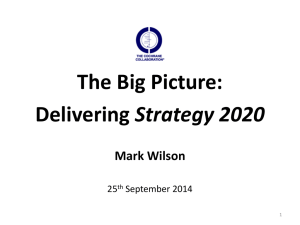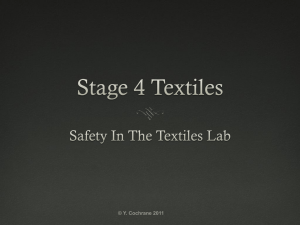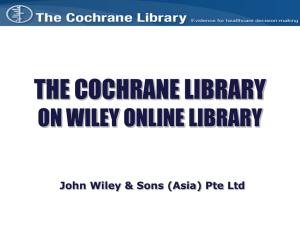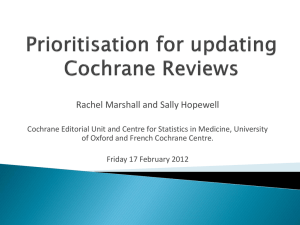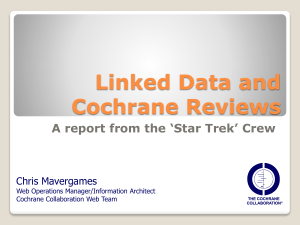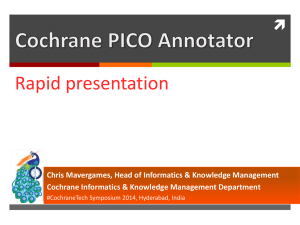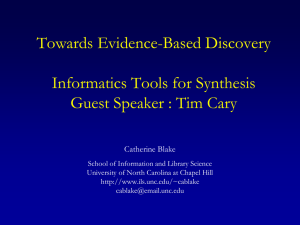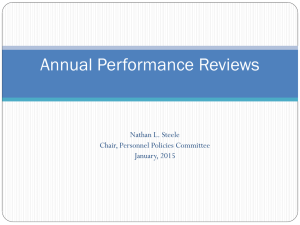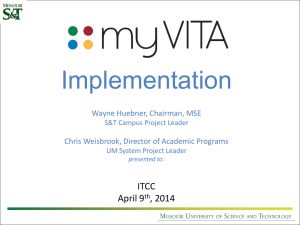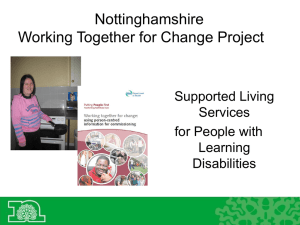workshop presentation - Cochrane Editorial Unit
advertisement
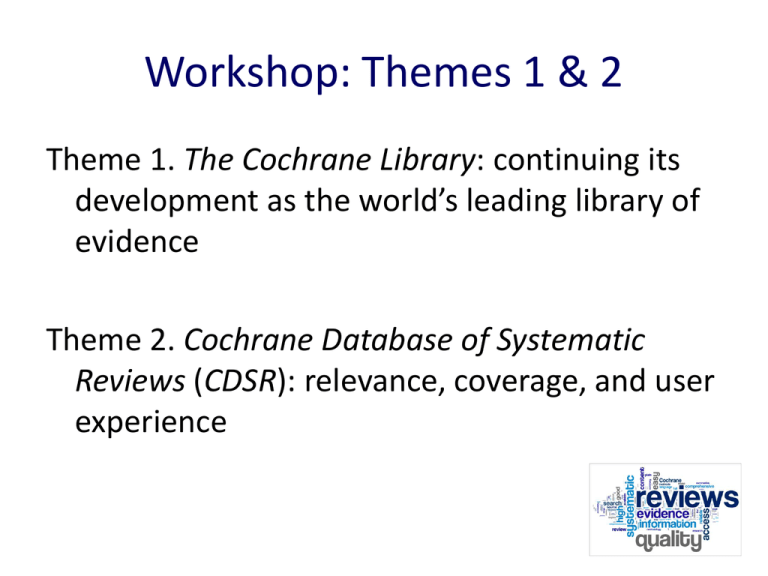
Workshop: Themes 1 & 2 Theme 1. The Cochrane Library: continuing its development as the world’s leading library of evidence Theme 2. Cochrane Database of Systematic Reviews (CDSR): relevance, coverage, and user experience Strengths and weaknesses User experience Range of databases The Cochrane Library Design, search, features Prioritization & customization Key user groups What do you like best about The Cochrane Library? Strengths • quality of the Cochrane Reviews and content • access to content (“easy & free accessibility”) • coverage and comprehensiveness of content (“comprehensive source of knowledge”) • concept, reputation, independence associated with Cochrane (“Excellent reputation, transparent, robust, good coverage”) • website (eg “Colourful, lively front page”) Weaknesses • search functionality (“trying to search using MeSH or natural language terms – I never know if I am getting everything”) • access to content (“not all the reviews are available for every reader in the library”) • readability or article design (“format of reviews is too long, unfriendly to busy readers”) • website (“the lack of clarity on the front page – you really have to know a lot about Cochrane already to make head or tail of it”) • topic coverage, including how topics are divided between Cochrane Reviews (“Many reviews are too large, and in contrast many cover too small a question”). 1& 3 Experience of using CLIB Experience of using CLIB (%) Very poor Quite poor Quite good Very good Recommend to friends or colleagues (%) Yes No Ways to improve: • searching experience • article-level experience • website • new types of content (eg reader resources and commentaries for Cochrane Reviews). Why not? • content is not consumer-friendly • access difficulties • poor readability • poor search functionality Key user groups 1. 2. 3. 4. 5. Those that use the content to inform healthcare decisions Clinicians and healthcare workers Researchers (including information specialists and guideline developers) Students Consumers (including patients and carers) Policy-makers Other groups are important too • Knowledge translation and dissemination – via media outlets, journalists, and bloggers to global audiences • Content ‘repackaging’ – via database providers, policy-setting bodies, and others • Providing access to content by purchasing institutional, regional, and national licences to The Cochrane Library • Providing funding for the preparation of Cochrane content Prioritising and customising 355 = no 51% 347 = yes 49% 2 Select your location 2 Range of databases 5 Integrating and cross-linking databases 6 Website design Look and feel Index content Link similar content Navigation Link to external content Search Reducing offline time and technical faults Cochrane universe 3 Priorities for The Cochrane Library • Maintain reputation for quality • Make it easier for people to access content High-quality content • Maintain the independence of Cochrane Reviews (eg free from conflicted funding) Make content accessible • Increasing awareness of Cochrane • improve relevance and coverage of Cochrane Enable it to be used Reviews • Keep content up to date • Continue to improve the website, including utilising technological advances 8 What is valued Topic coverage Meeting needs? Cochrane Database of Systematic Reviews Types of articles Non-English language users Low- and middle-income countries Cochrane Database of Systematic Reviews Scientific rigour Comprehensive topic coverage Most valued Independence from commercial funding Updating of Cochrane Reviews How well are Cochrane Reviews addressing priorities and needs? 87% = good job But...could improve How we prioritize topics Summaries Presentation of individual article 9 to 12 How we promote the use of Cochrane Reviews Low- and middle-income countries Prominence: – Prioritise and highlight – Setting and context 13 Access: – Improve access – Mobile phones – Internet bandwidth – Translation Non-English language users Translation strategy Translate key sections Develop search interfaces for other languages 14 Signpost translated content Web-based translation services Coverage of healthcare topics Overall coverage (no.) 1 22 Very poor 245 Quite poor Quite good 355 No rec, but further work Very good DynaMed: of 500 most frequently viewed topics in DynaMed, 81 topics (16%) with no Cochrane Review “shows a strong breadth of coverage for The Cochrane Collaboration” Diverticulitis Hyperthyroidism *2 Abnormal liver function tests - differential diagnosis *1 Anemia - differential diagnosis *1 Gout *2 Hyponatremia Dizziness - differential diagnosis *1 Abdominal pain - differential diagnosis *1 Celiac disease Types of articles Strong desire for the CDSR to include other article types: – registered review titles (ie reviews in development) – methodological articles – commentaries 15 Commentary Asdfdsff jadldjf ;adflkkjdf ;ajsdlj ;lajf adfa fjlkjsdf ;asfd aljf aljdf alsjfj aljsdf a;lsjdf aljfd alldf ljsdf;asdfj a;lkjf ooieujsdf a;ljsdf ;aljsdfjalk ;asfl ;asflj Visual presentation and user experience of Cochrane articles • Make key messages clearer • Improve readability (including making Cochrane Reviews more concise) • Improve the article format to make it more user-friendly and easier to navigate • Easier to print • help users differentiate the three PDF versions 10 Article metrics • Use in guidelines • Number of citations for the Cochrane Review (eg number of times cited in PubMed Central or Google Scholar) •Article access statistics (eg number of times review viewed) •Social bookmarking metrics? 16 Timely publication • 2010 moved from quarterly to monthly • 2013 move to publish when ready? 17 High-quality, high-impact content Web presentation Dissemination and knowledge translation Small groups Group 1 Rec no. Recommendation 3 ...improving The Cochrane Library website ... 10 ...article-level display of Cochrane Reviews... •The survey showed that our users like website best and least. What are the specific positives and negatives that they could be referring to, and what do you think? •Are there any specific changes you would like to see to CLIB (feel free to draw!)? •Some of our users think CLIB = Cochrane Reviews. Do you think this should be reflected in the design? If so, how? Group 2 Rec no. Recommendation 13 …improve how we meet the needs of readers and users from low- and middle-income countries… 14 …meet the needs of non-English language users… •How would you like to see this happen (also considering technology developments, eg semantic web)? •For access, Appendix 5 may be useful Group 3 Rec no. Recommendation 1 … access options for The Cochrane Library … 11 Promote the use of Cochrane Reviews … •What are the issues around access that need to be considered? (Refer to Appendix 5) •Think about working with health organizations Group 4 Rec no. Recommendation 15 Expand the range of article types… 7 …added-value features … •How could we make the added-value features more useful and increase awareness? (Refer to Appendix 6) Tasks • General questions for discussion: – Does the recommendation cover what you expect it to cover? – Is it achievable? – Suggestions and ideas for implementation? – Does it need to further consultation? With who? • For reporting back: – What do you want to record for us to take away? – What key points (eg 3 key points) would you want to report back to the plenary?

